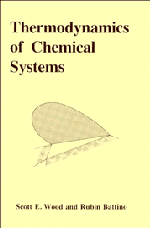Book contents
- Frontmatter
- Contents
- Preface
- Notation
- 1 Introduction
- 2 Temperature, heat, work, energy, and enthalpy
- 3 The second law of thermodynamics: the entropy function
- 4 Gibbs and Helmholtz energy functions and open systems
- 5 Conditions of equilibrium and stability: the phase rule
- 6 Partial molar quantities
- 7 Ideal gases and real gases
- 8 Liquids and solids: reference and standard states
- 9 Thermochemistry
- 10 Phase equilibrium
- 11 Chemical equilibrium
- 12 Equilibria in electrochemical systems
- 13 Surface effects
- 14 Equilibrium conditions in the presence of an external field
- 15 The third law of thermodynamics
- Appendices
- Cited references and selected bibliography
- Subject index
15 - The third law of thermodynamics
Published online by Cambridge University Press: 28 October 2009
- Frontmatter
- Contents
- Preface
- Notation
- 1 Introduction
- 2 Temperature, heat, work, energy, and enthalpy
- 3 The second law of thermodynamics: the entropy function
- 4 Gibbs and Helmholtz energy functions and open systems
- 5 Conditions of equilibrium and stability: the phase rule
- 6 Partial molar quantities
- 7 Ideal gases and real gases
- 8 Liquids and solids: reference and standard states
- 9 Thermochemistry
- 10 Phase equilibrium
- 11 Chemical equilibrium
- 12 Equilibria in electrochemical systems
- 13 Surface effects
- 14 Equilibrium conditions in the presence of an external field
- 15 The third law of thermodynamics
- Appendices
- Cited references and selected bibliography
- Subject index
Summary
The energy and entropy functions have been defined in terms of differential quantities, with the result that the absolute values could not be known. We have used the difference in the values of the thermodynamic functions between two states and, in determining these differences, the process of integration between limits has been used. In so doing we have avoided the use or requirement of integration constants. The many studies concerning the possible determination of these constants have culminated in the third law of thermodynamics.
We can obtain a concept of the problem by referring to the discussion in Section 7.12. There we derive expressions for the thermodynamic functions for an ideal gas by expressing the energy and entropy in terms of the heat capacities and the required integration constants. The result is that the expression for the Gibbs energy contains the term (ẽ – T), where ẽ and are the required integration constants for the energy and entropy, respectively. When we consider the difference between the values of the Gibbs energy of the ideal gas at two temperatures, ẽ cancels but the quantity (T1 – T2 remains. Therefore, in order to make the calculation, we need to know the value of. The result is the same when we consider substances other than an ideal gas. We are, therefore, concerned with the possible determination of the absolute value of the entropy.
- Type
- Chapter
- Information
- Thermodynamics of Chemical Systems , pp. 399 - 414Publisher: Cambridge University PressPrint publication year: 1990



